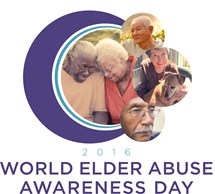It seems like one of the common principles that unite all cultures: Respect your elders.
But sometimes it doesn’t work out that way.
An under-appreciated problem
The problem of elder abuse in our country — and it is a serious problem, with the Department of Health and Human Services reporting it affects as many as 1 in 10 older Americans — is something that cannot be addressed before awareness among caregivers, families, and entire communities is increased. The truth is, as shocking as these numbers are, most abuse still goes unrecognized and unreported.
Why isn’t it more obvious?
For one thing, the isolation and dependence of some older people make the abuse difficult to detect and at times even harder for the victim to report. Older people sometimes are fearful of losing assistance or even being cut off from friends or family if they make any move to defend themselves.
Another complication is that elder abuse takes many forms. The reflex image is one of physical abuse, but that may represent less than 10 percent of victims. Far more common are things like financial exploitation and — most prevalent — verbal abuse.
Obviously, family dynamics and the stress of caregiving can lead to disputes between elderly people and their loved ones. An occasional disagreement or loss of patience is not necessarily a sign of abuse. But the language that humiliates, degrades, or threatens the victim is a clear indication that a more serious issue may exist.
Some signs that a relationship has deteriorated into a verbally abusive one include:
- Intimidation
- Using yelling to enforce one’s will on the elderly person
- Degrading or blaming the elderly person for incidental accidents or misfortunes
Similarly, financial exploitation may not be so obvious. As an adult, your senior loved one is free to spend their money and dispose of their belongings however they wish. But when this occurs in the context of an unequal relationship with a loved one, for example, or when a new “friend” begins to harm your elderly parent’s financial well-being, it’s time to seek some sort of intervention.
Common signals that an intervention may be needed include:
- Frequent lending of valuable items that never seem to be returned
- Unexpected withdrawals of funds or unexplained expenses
- The appearance of new “friends” who seem to have unusual influence over choices the older person makes
These are by no means exhaustive lists, and each case should be evaluated within its own context. But the sooner any abuse, or even the potential for it, is recognized, the more likely it is that you’ll be able to ensure the safety, security, and well-being of your family member.
What you can do:
- Talk honestly with your loved one about how interactions with others make them feel.
- Ask specific questions about any suspicious financial transactions or property “loans.”
- Meet and speak with any “new best friends,” particularly if they seem to be spending an unusual amount of time at your family member’s home.
- Talk to professionals about your concerns. It’s far better to be overly cautious than to miss an opportunity to make a positive change.
Most communities have some sort of counseling or intervention resource, usually at the county level. This may be called the Department of Human Services or Family Services or several other names. If you’re unsure where to go, start with a physician or clergyperson. Even if you don’t have an established relationship with these professionals, they are aware of services in the community and can advise you on the best course of action.
The first line of defense in stopping and preventing elder abuse is awareness.

World Elder Abuse Awareness Day is June 15, 2016.
World Elder Abuse Awareness Day (WEAAD) was started in 2008 to help bring attention to these growing issues. Consider sharing our Facebook post about elder abuse to help spread the word.